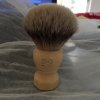Here's a thought for discussion... We compare vintage brush restores to current brushes in terms of specs. I have yet to see someone willing to drill out their Plisson or Simpson Chubby 2 to confirm-measure the knot size verses the hole size. The hole size has to be somewhat larger than the knot's glue-band size if you want a functional brush that seats and dries properly. The choice of which to advertise seems to be the marketing department.
When restoring, I experiment with hole size as much as knot size and loft setting. I like the hole size to look natural too. And if we made our own knots, we could absolutely tailor them to the handle, but we can't.
In pic #1, I recently installed a 22mm silvertip knot with a 29mm hole width (the same as a Chubby 2's advertised knot size) just to see its qualities. It has a 51mm loft and is drilled 17mm deep in a vintage, battle-worn Fuller handle. That's about 4mm deeper than I normally drill.
Frankly, it's a nice brush and functions great, even though it is certainly not as dense as a true 29mm knot would be in a similar rig. Yet it releases lather better that the denser knot described later. I doubt someone could fit a true 29mm knot in a handle with a 29mm hole unless it was drilled only for the band.
In pic#2, my 29mm hole size restores tend to have 27.5-28mm knots in them. It is quite luxurious but is almost too dense to be practical. I would have to assume the Chubby 2 would be similar. Sorry if the pictures are somewhat crude and don't show the best angle for this topic.


Pic #1 is post-bloom, 22mm knot in a 17mm depth, with a 29mm hole size, 51mm loft.
Pic #2 is pre-bloom, 28mm knot in a 13mm depth, with a 29mm hole size, 55mm loft.
When restoring, I experiment with hole size as much as knot size and loft setting. I like the hole size to look natural too. And if we made our own knots, we could absolutely tailor them to the handle, but we can't.
In pic #1, I recently installed a 22mm silvertip knot with a 29mm hole width (the same as a Chubby 2's advertised knot size) just to see its qualities. It has a 51mm loft and is drilled 17mm deep in a vintage, battle-worn Fuller handle. That's about 4mm deeper than I normally drill.
Frankly, it's a nice brush and functions great, even though it is certainly not as dense as a true 29mm knot would be in a similar rig. Yet it releases lather better that the denser knot described later. I doubt someone could fit a true 29mm knot in a handle with a 29mm hole unless it was drilled only for the band.
In pic#2, my 29mm hole size restores tend to have 27.5-28mm knots in them. It is quite luxurious but is almost too dense to be practical. I would have to assume the Chubby 2 would be similar. Sorry if the pictures are somewhat crude and don't show the best angle for this topic.


Pic #1 is post-bloom, 22mm knot in a 17mm depth, with a 29mm hole size, 51mm loft.
Pic #2 is pre-bloom, 28mm knot in a 13mm depth, with a 29mm hole size, 55mm loft.





